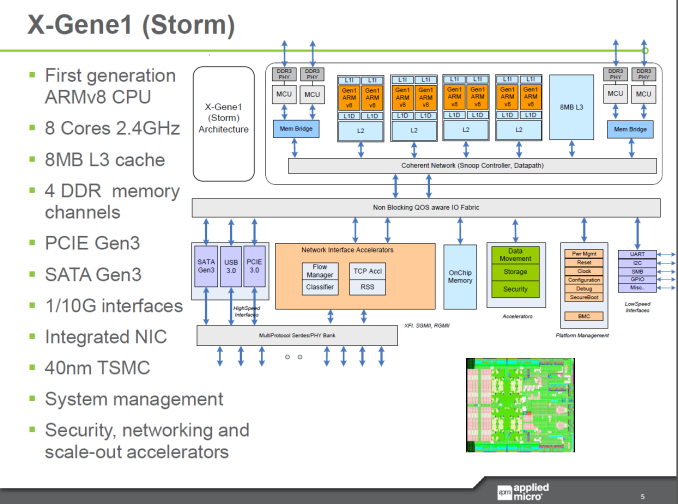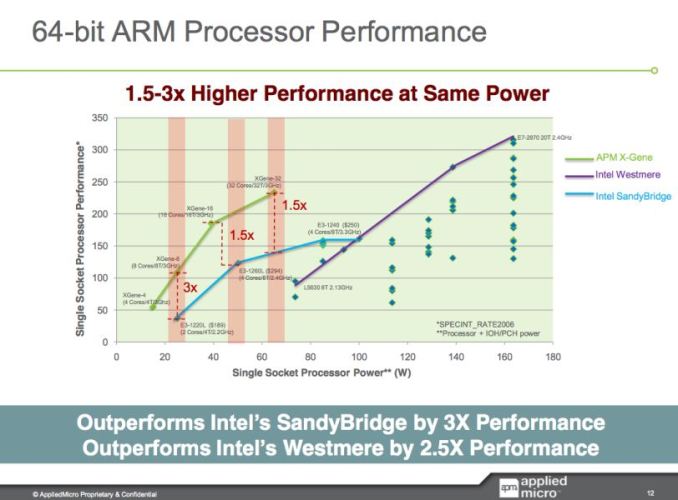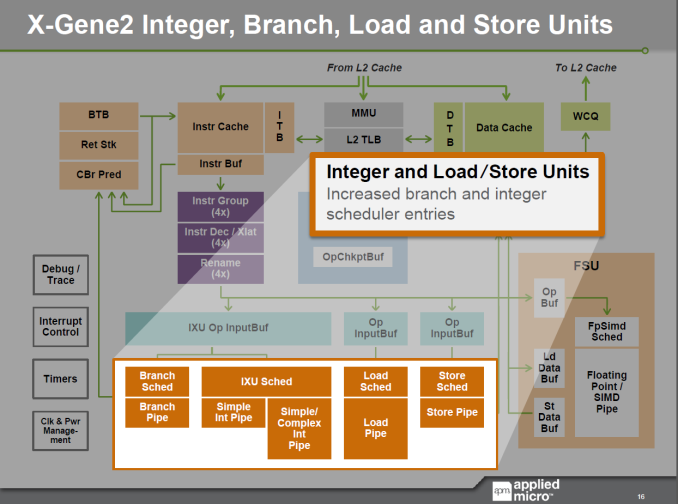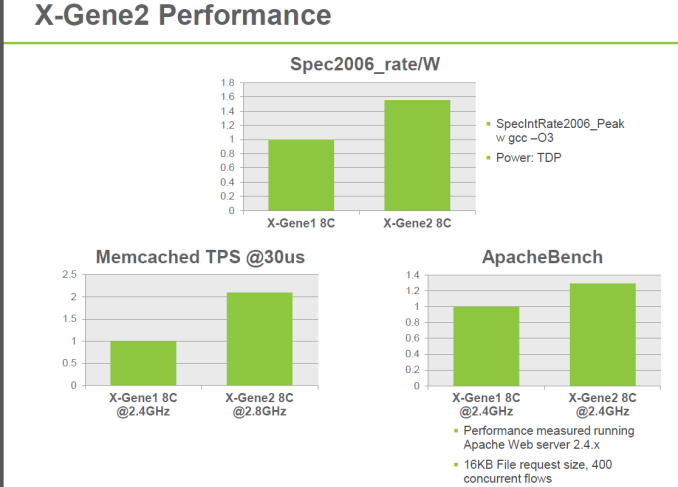ARM Challenging Intel in the Server Market: An Overview
by Johan De Gelas on December 16, 2014 10:00 AM ESTThe ARM Based Challengers
Calxeda, AppliedMicro and ARM – in that order – have been talking about ARM based servers for years now. There were rumors about Facebook adopting ARM servers back in 2010.
Calxeda was the first to release a real server, the Boston Viridis, launched back in the beginning of 2013. The Calxeda ECX-1000 was based on a quad Cortex-A9 with 4MB L2. It was pretty slow in most workloads, but it was incredibly energy efficient. We found it to be a decent CPU for low-end web workloads. Intel's alternative, the S1260, was in theory faster, but it was outperformed in real server workloads by 20-40% and needed twice as much power (15W versus 8.3 W).
Unfortunately, the single-threaded performance of the Cortex-A9 was too low. As a result, you needed quite a bit of expensive hardware to compete with a simple dual socket low power Xeon running VMs. About 20 nodes (5 daughter cards) of micro servers or 80 cores were necessary to compete with two octal-core Xeons. The fact that we could use 24 nodes or 96 SoCs made the Calxeda based server faster, but the BOM (Bill of Materials) attached to so much hardware was high.
While the Calxeda ECX-1000 could compete on performance/watt, it could not compete on performance per dollar. Also, the 4GB RAM limit per node made it unattractive for several markets such as web caching. As a result, Calxeda was relegated to a few niche markets such as the low end storage market where it had some success, but it was not enough. Calxeda ran out of venture capital, and a promising story ended too soon, unfortunately.
AppliedMicro X-Gene
Just recently, AppliedMicro showed off their X-Gene ARM SoCs, but those are 40nm SoCs. The 28nm "ShadowCat" X-Gene 2 is due for the H1 of 2015. Just like Atom C2000, the AppliedMicro X-Gene ARM SoC has four pairs of cores that share an L2 cache. However, the similarity ends there. The core is a lot beefier and it features 4-wide issue with an execution backend with four integer pipelines and three FP pipelines (one 128-bit FP, one Load, one Store). The 2.4GHz octal-core X-Gene also has a respectable 8MB L3 cache and can access up to four memory channels, with an integrated dual 10GB Ethernet interface. In other words, the X-Gene is made to go after the Xeon E3, not the Atom C2000.
Of course, the AppliedMicro chip has been delayed many times. There were already performance announcements in 2011. The X-Gene1 8-core at 3GHz was supposed to be slightly slower than a quad-core Xeon E3-1260L "Sandy Bridge" at 2.4GHz in SPECINT_Rate2006.
Considering that the Haswell E3 is about 15-17% faster clock for clock, performance should be around Xeon E3-1240L V3 at 2GHz. But the X-Gene1 only reached 2.4GHz and not 3GHz, so it looks like an E3-1240L v3 will probably outperform the new challenger by a considerable margin. The E3-1230L (v1) was a 45W chip and the E3-1240L v3 is a 25W TDP chip, and as a result we also expect the performance/watt of an E3-1240L to be considerably better. Back in 2011, the SoC was expected to ship in late 2012 and have two years lead on the competition. It turned out to be two months.
Only a thorough test like our Calxeda review will really show what the X-Gene can do, but it is clear that AppliedMicro needs the X-Gene2 to be competitive. If AppliedMicro executes well with X-Gene2, it could get ahead once again... this time hopefully with a lead of more than two months.
Indeed, early next year, things could get really interesting: the X-Gene2 will double to the amount of cores to 16 (at 2.4GHz) or up the clock speed to 2.8GHz (8-cores) courtesy of TSMC's 28nm process technology. The X-Gene2 is supposed to offer 50% more performance/watt with the same amount of cores.
AppliedMicro also announced the Skylark architecture inside X-Gene3. Courtesy of TSMC's 16nm node, the chip should run at up to 3GHz or have up to 64 cores. The chip should appear in 2016, but you'll forgive us for saying that we first want to see and review the X-Gene2 before we can be impressed with the X-Gene3 specs. We have seen too many vendors with high numbers on PowerPoint presentations that don't pan out in the real world. Nevertheless, the X-Gene2 looks very promising and is already running software. It just has to find a place in a real server in a timely fashion.














78 Comments
View All Comments
patrickjchase - Thursday, December 18, 2014 - link
It's been a while since I worked on this stuff, but I don't think that the statement that "CCN is very comparable to the ring bus found inside all Xeon processors beginning with Sandy Bridge" is quite right.CCN
patrickjchase - Thursday, December 18, 2014 - link
Finishing my comment:CCN
stefstef - Wednesday, December 17, 2014 - link
the idea of having an energy efficient design certainly will pay off. nvidia and samsung showed that having i.e. 4 cores and a fifth core dedicated to the energy management can be a good low cost solution. i dont often read the articles at anandtech because they are usually boring. although i am happy to place a coment here. arm rules in certain fields but in a couple of years only because intel will allow them to do so. every company needs a room to live in. another american breakfast for the chinese who will get their share in the processor market as well.milli - Thursday, December 18, 2014 - link
I don't understand how ARM is suddenly going to succeed while MIPS and PowerPC have already tried and failed. I feel that ARM is more of a market trend than anything else (in the server market).Even the current ARM server SOC manufacturers have already tried to penetrate the server market. Cavium and Broadcom already had custom designed low-power MIPS SOCs. IBM, Applied Micro and Freescale have had a bunch of low-power PowerPC options.
By the time any of these products is released, Intel is going to have a better alternative thanks to their process advantage. No IT manager is going to manage to convince any of the corporate fat-cats that a huge overhaul is needed. Same story over again.
yuhong - Friday, December 19, 2014 - link
"Unfortunately their 16GB DIMMs will only work with the Atom C2000, leading to the weird situation that the Atom C2000 supports more memory than the more powerful Xeon E3."I think the reason is software related. More precisely, the Memory Reference Code (MRC).
intiims - Tuesday, December 30, 2014 - link
If You want to know something about External Hard Drives visit http://www.hddmag.com/adrian1987 - Monday, January 5, 2015 - link
Hi. The Haswell core can actually have a max IPC of 6 instructions per cycle using macro-fusion not 5 as listed here (assuming the code is ideal). It has 2 execution units that can handle fused ALU and branch instructions. Source: http://www.anandtech.com/show/6355/intels-haswell-...aaronjoue - Tuesday, April 7, 2015 - link
Here is the real micro server. http://www.ambedded.com.tw/pt_list.php?CM_ID=20140...http://wiki.ambedded.com.tw/index.php?title=MicroS...
7 & 21 nodes in a chassis
It support Ubuntu and open source Ceph.